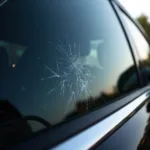Car window molding is a critical component that seals your car’s windows, preventing leaks, wind noise, and damage to the car’s interior. Over time, this molding can deteriorate due to exposure to the elements, leading to various problems. This guide delves into the intricacies of car window molding repair, equipping you with the knowledge to address these issues effectively.
Understanding Car Window Molding
Car window molding, often referred to as window seals or weatherstripping, comes in various forms, each serving a specific purpose. The most common types include:
- Outer Molding: This type runs along the door frame’s exterior, creating a seal between the door and the window glass.
- Inner Molding: Located inside the door panel, this molding prevents water and debris from entering the car’s interior.
- Beltline Molding: Positioned along the window’s lower edge, this molding offers protection and a sleek aesthetic appeal.
Signs of Damaged Car Window Molding
Recognizing the signs of damaged car window molding is crucial for prompt repair and preventing further issues. Here are some telltale signs to watch out for:
- Water Leaks: One of the most obvious signs is water seeping into your car’s interior, particularly during rain or car washes.
- Increased Wind Noise: Deteriorated molding can compromise the seal around your windows, resulting in noticeable wind noise at higher speeds.
- Visible Damage: Cracks, tears, or detachment of the molding are clear indicators of damage that requires attention.
DIY vs. Professional Car Window Molding Repair
Deciding whether to tackle car window molding repair yourself or seek professional help depends on your comfort level with car maintenance and the severity of the damage.
DIY Repair: Minor damage, such as small cracks or loose sections, can often be addressed with DIY solutions. Several adhesive products and replacement molding kits are readily available at auto parts stores.
Professional Repair: For extensive damage, such as significant tears or complete molding detachment, seeking professional help is recommended. Professionals have the expertise, tools, and access to high-quality materials to ensure a long-lasting repair.
Car Window Molding Repair Cost
The cost of car window molding repair can vary significantly depending on factors like:
- Extent of Damage: Minor repairs typically cost less than major replacements.
- Type of Molding: Some molding materials, like chrome accents, can be more expensive than standard rubber seals.
- Labor Costs: Professional labor rates can vary based on location and the mechanic’s expertise.
On average, expect to pay between $50 to $250 for DIY repairs, while professional repairs can range from $100 to $500 or more.
Preventing Car Window Molding Damage
Proactive measures can significantly extend the life of your car window molding. Here are some preventative steps:
- Regular Cleaning: Clean your car’s window molding regularly using a mild soap solution and a soft brush to remove dirt, grime, and debris.
- UV Protection: Park your car in shaded areas or use a car cover to protect the molding from prolonged sun exposure, which can cause fading and deterioration.
- Silicone Lubricant: Applying a silicone-based lubricant to the molding can help maintain its flexibility and prevent cracking, especially in colder climates.
Conclusion
Maintaining your car window molding in good condition is vital for a comfortable and safe driving experience. By understanding the common signs of damage, considering DIY versus professional repair options, and adopting preventative measures, you can ensure the longevity of your car’s window seals and keep your vehicle running smoothly.



